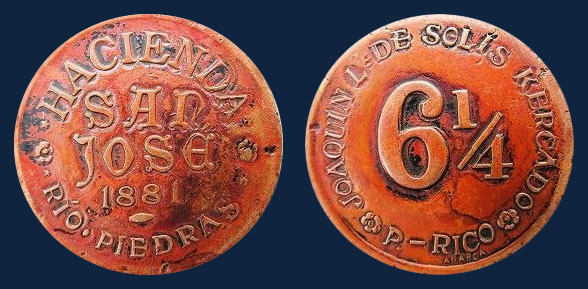
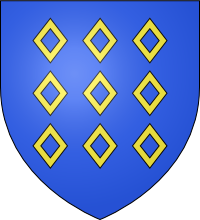
left : primitive arms (Olivier's seal in 1262) and right : actual arms
2 mascles were added when the shields became wider on the bottom (17th century)
These arms have always been identical to the Rohan's except the color.
This House takes its name from the office of Grand Seneschal of Britanny it occupied hereditarily since its creation by Eudon II, sovereign of Britanny ( 1148-1156 ). A fief was attached to that dignity and called the Sénéchallie. It was composed of castellanies of Cœrniel, Mortedonon, Uzel, St. Caradec, Cadelac, Molac, and formed with the other rights of the office, an income of 3,000 pounds, according to an act of 1259. We can read in some documents that the house Le Seneschal is a junior branch of that of Rohan, but the family " has never supported the positive or acquiesced the negative."
The Le Seneschal Kercado had the honors of the court March 29, 1777 with the title of Marquis.
In each page of the history of France, we find this family honorably mentioned. It never stopped giving, by the arms, active proof of its loyalty to the King, and one keeps the memory of Jean Kercado who at the battle of Pavia, seeing an arquebusier shooting at King François 1st rushed between him and the monarch, and by the sacrifice of his life, saved the King. Before the Revolution, seven colonels of the name were killed at the head of their regiments, at the sieges of Lerida, Turin, Prague, at the battle of Senef, etc. Never was their ardor denied and, more unusually in such a long line, they were always loyal to their principles.
The land of Kercado (yore Carcado), located at Saint-Gonnery in the Morbihan, was brought in dowry in the house Le Senechal by an heiress of that name, en 1320, and remained in the family since then. The land of Kerguisec (or Kerguisé), in Surzur, was brought in dowry in the house Le Senechal by an heiress of that name in the XVIth century.
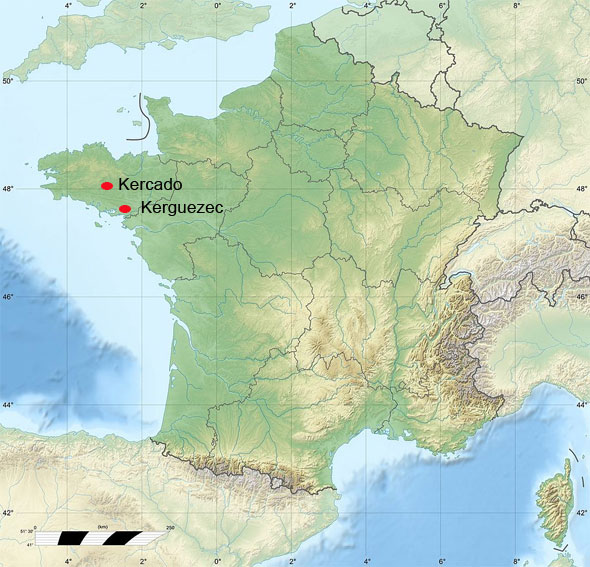
- Daniel, is known by a founding charter, by Alain III de Rohan and Constance de Bretagne, his wife, of the abbey of Bonrepos in 1184. In that charter Daniel is quoted as one of the witnesses, as he is also in a second charter by which the same Alain de Rohan confirmed a few years later, a donation to the Abbey of some churches located in England.
- Fraval, is qualified "knight and Daniel's son" in an act dated 1204 and in another one dated 1213. He has two sons : Olivier, who follows, and Alain, qualified "Sire hereditary and feudal seneschal of Rohan, knight, and Fraval Le Senechal's son" in a charter of the abbey of Bonrepos, dated 1254.
- Olivier, knight and feudal seneschal, was in 1262 witness of a transaction and affixed his seal on the document. He had many disputes with Alain IV, viscount of Rohan, about the rights he held in the viscounty.
- Fraval II is qualified knight in a charter dated 1272.
He is the father of Olivier, in the descent of whom the dignity of Seneschal of Rohan ended in 1641, and of Eudon, who is the author of the branch of Kercado.
- Olivier II, Sire, hereditary and feudal seneschal of Rohan, had ony one daughter, heiress of the office of Seneschal as well as of the Sénéchallie attached to that office. She married Josselin de Trébrimoel who had also ony one daughter who was seneschal of Rohan after her mother. She brought in dowry all her possessions to Guy de Molac, sire of Molac, who passed them to his male descendants until Guy de Molac, last of that name, who died in 1411 leaving a daughter Jeanne. Jeanne de Molac married Pierre de Rieux, Marschal of France, who became seneschal of Rohan. The couple did not have any children and the rights of the Senechallie with the title of hereditary seneschal of Rohan went to Guy de La Chapelle. It sayed in that family for several generations and passed in the Rosmade family. In 1641, Sebastien de Rosmadec sold to Marguerite de Rohan, all the rights of the Sénéchallie with what was left of the possessions. Thus was extinguished after more than five centuries this office of Seneschal of Rohan.
- Eudon, who follows.
- Eudon or Eon, received from his brother, amongs others, the lordship of Bot, in the parish of Saint-Caradec. He married Olive, lady of Kercado, heiress of this House, by whom he had five sons whom often spoke historians of Brittanny.
- Alain eldest son and principal heir, and as such lord of Kercado and Bot, died in 1372 in his mansion of Bot. He was first married to Jeanne de Plœuc by whom he had a daughter, and secondly to Johanette du Pont, of the house of Pont-l'Abbé, by whom he had Even, which follows, and Pierre who was killed in the defense Montmartre in 1411 .
- Even, lord of Kercado, Bot, etc., inherited the lordship of Brohais as closest parent of Guillot de Quenesquen. He put his seal on an act of the viscount of Rohan, dated 26 aug 1419, which was seven mascles with cotice, showing juveigneury of the lords of Kercado and their offspring, of the ancient lords and hereditary seneschals féodés of Rohan. Even accompanied the Duke of Brittany and his brother the Duke of Richmond, in the trip they made to Amiens in 1423 to strike a accommendement between King Charles VII and the English. He concluded an agreement with Olivier Chastel 9 oct 1429, agreement sealed the same seal as above. He died in the same year. He married Jeanne La Vache by whom he had seven son and two daughters.
- Thibauld, knight, lord of Kercado, Bot, Brohais, etc., was also lord of Noyant and Pilmil in Maine, and of Preil-Robert in Anjou.
François 1st, duke of Britanny, gave him the command of an army that was
sent in Normandy against the English, where he won several advantages, as indicated in a Duke's order in his favor sent 11 oct 1447 : We command
our souls and trusty counselors tenans our general assignments, to deliver the sum of six hundred crowns to our knight feal Thebauld the Senechal, Lord Kercado,
in reward for the troops and men of war that the said knight as led for our service in Normandy, and for the value he has shown in many good and important opportunities, etc.
Thibault received two acts of homage-lige 18 jan 1454 and 19 nov 1455 and he died not long after.
He married Jeanne, daughter of Jean du Fou, ambassador of Britanny in France in 1390, on of the greatest names of the Province, descendinf from Ehwarn, viscount and Prince of Leon in the Xth century. She brought as dowry in 1414 the lordship of Plesse-Chamillart and the castelleny of Courcelle-la-Tour, in Maine. They had one son and three daughters. - Guillaume, lord of Kercado, of Bot-Saint-Caradec, of Brohais, in Britanny, of the castellies of Courcelle-la-Tour, of la Plesse-Chamillart in Maine, etc., married fistly 1 jan 1444 Sybille Le Veyer, whose father gave her 2 years before the manor of Coetmenech, and whose godmother also named Sybille Le Veyer, had given her one third of her inheritages and a great quatity of precious furnitures. She died without children and Guillaume married secondly, 12 oct 1463, Yolande de Rohan du Gué-de-L'Isle, grand-grand-daughter of Alain, viscount of Rohan. On that occasion, Jean de Rohan gave his sister 200 gold écus and an income of 40 pounds. They had several children. Guillaume was attending a "monstre" in Vannes 8 sep 1464.
- Jean, knight, lord of Kercado, of Bot-Saint-Caradec, of Brohais, etc. was put after the death of his father in the care of his mother, as he appears in a sentence given in Pontivy 11 oct 1473 and other documents dated 1477. He also has as curators Yvon du Fou (in 1474) and his uncle Jean de Rohan (in 1481). Il married Simone, daughter of Louis d'Avaugour (who is not the one who married Anne de Malestroit, as some mistakenly beleive, nor even of the name of Avaugour already almost completly estinguished, but only a gentleman of the House of Bellouan, whose grandfather Jean de Bellouan had married Blanche d'Avaugour, grand-daughter of Louis et Anne de Malestroit, and by contracting the marriage, he had committed to take the name and arms of his wife). She brought as dowry to her husband the share she received in the lordships of Saint-Lean and Vay. Jean Le Sénéchal was already dead in september 1497. Their children were Jean, who was killed at the battle of Pavia (1525), Guillaume, who follows, and Marie.
- Guillaume II, lord of Kercado, of Bot-Saint-Caradec, of Brohais, etc., was declared his mother's principal heir by will dated 10 oct 1531.
He did not long possessed this inheritance, neither his father's, since he wrote his will in the month of december 1533, probably reached by a disease that prevailed.
In this will
he elected his burial in the church of Saint-Gonneri (parish where the castle of Kercado is located).
He had married Catherine de la Motte de Vauclerc, daughter of Guillaume de Rohan, sire of Montauban, and of Bonne Visconti, daughter of the duke of Milan who was dispossessed by Galeas. She brought him 11 may 1543 the viscounty of Maugremieu and the lordship of Châteauneuf-en-Goello. Among several children, was Robert, who follows. - Robert, lord of Kercado, of Bot-Saint-Caradec, of Brohais, etc., viscount of Châteauneuf-en-Goello and of Maugremieu, by her mother,
was declared eldest son and principal and noble heir under the act 14 nov 1549. He was in 1568 guardian of his cousin Joseph de La Motte-Vauclerc's children.
He distinguished himself by his firmness and his problems with the Guises, which he was parent by Simone d'Avaugour.
He took a stand against them in Britanny, although he was attached to the Catholic religion. He wrote his will 26 dec 1533.
He maried firstly Marie de Tregarenteuc by whom he had François, who continues the line with the barons of Kercado and the branch of the marquis de Molac, and secondly Jeanne Maydo by whom he had Tanneguy, who follows, and two girls. - Tanneguy, son of Robert et Jeanne Maydo, lady of Tréduday, second wife,
owned a great number of lands: besides Tréduday in Theix, her mother
left him Le Val-Jouin in Lizio, and La Ville-Denoual in Guégon. Furthermore his wife Jeanne de Kerguizec brought in dowry Kerguisec (Kerguezec) in Surzur, La Sauldraye in
Plumenec and le Rhéau in Sérent.
They had at least 2 children :
- René, who follows;
- Louise, married 10 nov 1617 Jérôme de Botdéru, squire, lord of Kerdreho and other places, advisor to parliament of Britanny.
- René, lord of Tredudai, Kerguisec and Kergoual, was married to Julienne Peschart, who brought in dowry the viscounty of Pacé, and by whom he had at least 7 children, including these
4 sons ;
- Julien, knight, lord of Tredudai, Kerguisec, etc., viscount of Pacé, knight of the order of Saint-Michel, married in 1646 Catherine Gouyon de Vandurant by whom he had only one daughter and heiress who brought in dowry the land of Tredudai to the lord Pont Deschilly ;
- René, dead without children;
- Jean, who follows;
- François, knight, lord of Bonnepart, married Marie de Marigné by whom he had a son Louis, killed at war without posterity, and 2 daughters.
- Jean, lord of Kerguisé and Cohanno, viscount of Pacé, died 17 apr 1697 and was buried in the church St Peter of Vannes. Jean, qualified "lord of Passé" married 29 feb 1669 same church, Jeanne Cousturet, (see parish register) by whom he had Pierre-René, who follows, and Charles-Louis baptized in Theix, 16 dec 1673 ;
- Pierre-René, lieutenant of the marshals of France, was born and baptized 8 apr 1670 in parish St Peter of Vannes (see parish register). His godfather is René Le Sénéchal, lord of Kerguisec, his grand-father. When he married Marie de Bruc 24 jan 1696 in the church Notre-Dame de Nantes (see parish register) he is qualified "knight, lord of Passé".
- Luc-Julien married 1° 15 jan 1725 Mary Rogon, lady of Crossac, by whom he had 5 children all baptized at Crossac and 2° 19 feb 1737 at La Haie-Fouassière his cousin Alexandrine-Jeanne-Rosalie, daughter of François-Philippe de Bruc, earl of Montplaisir (see parish register) by whom he had 5 children also baptized at Crossac. He always signs "Le Sénéchal de Kerguisé". In 1748 his residence is the castle of Cohanno in Surzur area (Britanny). He was qualified lord of Kerguisé, of Cohanno and Tohannic, viscount of Pacé. He was lieutnant of the marshals of France and was receiving a pension from the king for a wound received during a battle.
- Joseph-Innocent born 23 may 1742, was baptised in Crossac (60 kms north-west of Nantes) 25 may "son of Luc Julien Le Sénéchal, knight, lord of Kerguisé and other places". His godfather is Corentin-Joseph de Kercado-Molac, abbot of the Abbey of Bithaine, and his godmother is Innocente-Catherine de Bougé du Plessis-Bellière, marquise of Coetanfao (see church register). He obtained a lieutenancy 20 oct 1755 in the Bresse regiment of foot and was with that regiment at the battle of Saint-Cast in 1758 where the English were defeated. He was Lieutenant of the maschals of France 1758-1771 (Since 1566 duels are forbidden in France and the conflicts between aristocrats are regulated by the marshals or rather their lieutenants). He was witness at the wedding 4 may 1762 of a captain in his regiment (Durand du Massis) and qualified "high and mighty lord Joseph-Innocent Le Sénéchal, lieutenant in the Bresse regiment of foot". When the regiment of Bresse was suppressed the same year (1762), he went to Saint-Domingue (now Haïti), as aide-de-camp of Louis-Armand de Rohan, prince of Montbazon, governor general of the french isles "sous-le-vent" (Leeward Antillas). Thanks to this powerful protector, he contracted a wealthy marriage with Marie-Geneviève-Pierre Cottin de Saint-Leger 8 jan 1767 at Croix-des-Bouquets, the prince being witness. She was the heiress of a captain who had a very important "habitation" in this isle. It was at Joseph-Innocent's request that Mr Cherin, the genealogist of the court, checked all the proofs of nobility and sent orders to the Higher Council of Saint-Domingue to make the registration, such that he and his brother Aurelien-Joseph could benefit of the privileges of nobility in this colony ; which was performed at Port-au-Prince 20 nov 1772. He made a journey to France to establish his sons and died there, in Bordeaux, 13 jan 1777 at the age of 35 (having probably contracted a disease) and was buried the following day in the basilica Saint-Seurin : "The 14 jan 1777 was burried in the chapel Saint-Martial (now Sacré-Chœur) of this church, the body oh high and mighty lord Messire Joseph-Innocent, viscount Le Senechal, husband of Madame Marie-Magdeleine-Geneviève Cottin de Saint-Léger, living at Cul-de-Sac, isle of Saint-Domingue, deceased previous day, having received the sacraments of the Church, the said lord was native of the parish of Crossac, diocese of Nantes, in Britanny, etc." There is on the wall a marble plate on which is engraved : "Here lie the ashes of Sir Joseph Innocent Vicomte Seneschal Kercado, buried 14 January of the year 1777" His wife died at the age of 32 and was buried 27 sep 1780 in the cemetery of Port-au-Prince (Saint-Domingue). They had 4 sons born under the name "Le Sénechal de Cardado" in Croix-des-Bouquets 1768, 1769, 1771 and 1772
- Joseph-Pierre-Marie-Louis-Léger, christened 15 jul 1768 at Croix-des-Bouquets, buried in cemetery of that place at the age of 4;
- Jacques-Alexandre-Marie-Innocent, born 26 sept 1769, christened 16 dec 1769 at Notre-Dame du Rosaire church in Croix-des-Bouquets, said earl of Kercado-Kerguisé, officer in the regiment of Berry (1787), lieutenant of the marschals of France in Vannes 1785-1792, landlord in Port-au-Prince and Croix-des-Bouquets, died in Paris during the Revolution aged 31 (25 aug 1801). He had 5 children by his wife Catherine de Saulx de Tavannes (wedding contract signed by the royal family 11 feb 1787). His grand-son the earl of Kercado-Kergusié (1827-1881) was the last male of this branch;
- Jean-Baptiste-Laurent-Léger, who follows;
- Roger-Paul, christened 17 may 1773 at Croix-des-Bouquets, buried in cemetery of that place at the age of 3;
- Innocente-Gabrielle-Angélique, who was countess canoness of the noble chapter of Coryse-en-l'Argentière in 1789 ;
- Jean-Baptiste-Laurent-Léger also named Lorenzo de Kercado, is the stem of the Kercados of Puerto-Rico. He was born 17
jul 1771 and christened
3 aug at Croix-des-Bouquets (Saint-Domingue) in the same church as his brother. His father took him to France (arriving in Lorient
on the Constant), he made his proofs for being an officer 14 dec 1784 and entered the King's bodyguards
21 mai 1786. During the French Revolution he went back to Saint-Domingue (he is on the list of plantation owners in 1789) where he married Marie-Louise Bobin 3 may 1791 in
Croix-des-Bouquets. On the wedding registration he is qualified "viscount Le Sénéchal de Kercado".
According to a sequestration lifting document 22 nov 1802, we know that the Le Senechal de Kercado family(ies) owned in Saint-Domingue a house in Port-au-Prince, half of a sugar plantation (habitation Kercado) at Cul-de-Sac,
7/36 of
a sugar plantation (habitation Noailles) at Cul-de-Sac, half of a cofee plantation at Grands-Bois, and 1/8 of 2 sugar plantations at Arcahaye.
We can read in Mémoires pour servir à l'histoire de la révolution de Saint-Domingue (Paris, 1819) "From the beginning of the action, detachments were sent to the homes of wealthier owners, forcing them to take part in combat.
Her young husband, wealthy heir who was to embark the next day with his wife to the United States, was snatched from his home, and was the first fire in a fatal injury."
Actually the one who was "assassinated", as we can read otherwise, must be one cousin since "Lawrence Kercado" came to Charleston, South Carolina, in 1791, was in 1792 in Philadelphia
(he was the owner of Chalkley Hall 1792-1794), where his son Gustave was
born 31 jul 1793, and was leaving in 1796 at Elizabeth, New Jersey, as he writes -in french- in a letter to Alexander Hamilton (Secretary of the Treasury). In
that letter dated Philadelphia 6 jun 1796 (Hamilton papers, Library of Congress), he states that he has given orders for his property in Saint-Domingue to be sold and that he wishes to go there
to settle his affairs. He asks Hamilton to urge President Washington to grant him a Government commission which would assure him a safe passage to and from Saint-Domingue
and suggests that he be named agent for obtaining the release of American sailors imprisoned by the British.
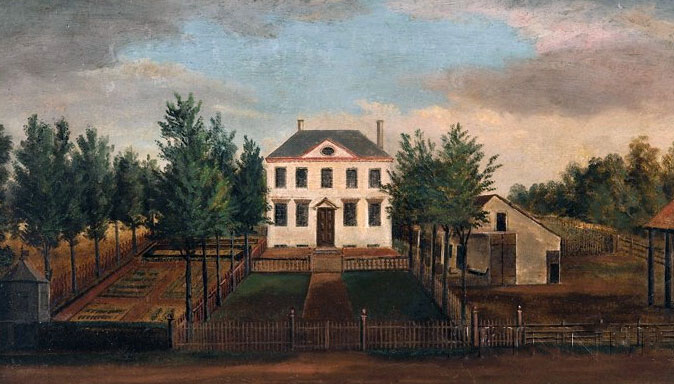 Chalkley Hall in Philadelphia
Chalkley Hall in Philadelphia
Lawrence John Ledger Le Senechal de Kercado, a refugee from San Domingo, was the owner 1792-1794
"An old summer-house on the Wamrath place, is said to have been the spot where the Declaration of Independence was planned, or at least where Jefferson and other Congressmen came on the afternoon of the day of signing the Declaration".
Things did no turn that way and Lawrence did not return to Haïti since we find him in Puerto-Rico as "farmer in a plantation of the duc of Crillon" (3rd son of the duke of Crillon-Mahon, french general at the service of Spain, who had been given lands in Puerto-Rico by the King, in 1776, with permission to send foreign families to cultivate them). In 1792 the conditions were renegociated and the duke was allowed to sell lands to solvent catholics foreigners, residing in spanish kingdoms. It was granted both the Duke and their settlers a period of four years for the start of the farms. The families Le Senechal (they changed their name to "de Kercado" which sounds more spanish) and Le Doux went together to Puerto Rico (they were close friends and in 1826 a "Madame Ledoux" signed for herself and for "M. Gustave de Kercado et de madame Nathalie de Solis" a petition concerning the indemnity due to the planters by the Government). The governor don Ramon de Castro, given the warlike circumstances, did not allow them entry into the bay of San Juan (3 jun 1796) and they were forced to anchor in the island of Santo Tomas with their ship loaded with 59 slaves, free workers and their families, and more relevant agricultural ustensils. They corresponded with the Duke of Crillon-Mahon to overcome these difficulties. Kercado and Ledoux not only requested to enter Puerto Rico, but the autorization to sell abroad timber from their plantation plus 4000 beefs and 2000 mules to recover from the losses suffered consequent to the refusal of the governor Castro. They also asked autorization to establish at their place a surgeon apothecary, a doctor and a chaplain to say mass. These last requests were granted as well as selling timber, but not the one on cattle, despite the favorable report from the secretary of the Royal Treasury Don Francisco Saavedra, who defended these settlers, noting that they were not miserable upstarts in search of fortune, but wealthy individuals and practices in colonial works, who have capital and workers, which is very convenient for the agricultural development of Puerto-Rico. So they could establish themselves as settlers of the duke of Crillon-Mahon and could acquire lands for their own account (Panorama historico de la agricultura en Puerto Rico). They did so, and Lorenzo bought one part of the Vergara hacienda (plantation) in 1799 for 2 875 pesos and 1 apr 1800 another hacienda, probably of sugar cane, in Rio Piedras for 14 000 pesos thanks to a loan obtained from the American merchant Anthony Butler. He also bought the hacienda San Francisco 19 may 1809 from Franisco Senac. The 1812 slaves conspiracy started in "Lorenzo de Kercado's hacienda". He is considered as a promoter of agricultural development in Puerto Rico.
- Gustavus Maria Alexander was born in Philadelphia (USA) 31 jul 1793 (St Joseph's church). He followed his father to Puerto-Rico where he married Mercedes Solis y Nuñes who was born in Cadiz (Spain) abt 1803 by whom he had several children : Charles (abt 1827-bef 1893), Joachim Modest (abt 1829-1898), Rachel (abt 1831-?), Manuel (abt 1834-1911), Gustavo (abt 1836- ?), Francisco (abt 1838-1884), Emmanuel or Lorenzo (1841-1911), Alfredo (abt 1843-1915), who follows, José Lorenzo (1847-1911). At the age of 46 (2 apr 1839), he returned to the USA with his wife and 5 children : Charles, Joaquin, Gustavus, Manuel and Alfred (see passengers list below). There he was a farmer at Falls, Bucks county, Pennsylvania (according to tax records 1848, 1849, 1851 and census of 1850, 1851). The information on births is generally found on the death records and, being declaratives,cannot be considered as reliable. We don't know wether Gustavus returned or not to Puerto Rico neither where and when he died, but he doesn't seem to be in Falls after 1851 (but his son Joaquim is still there ; see here) and Mercedes Solis died in Puerto Rico 2 nov 1893 (see deaths register), and she is declared Don Gustavo de Kercado's widow.
- Alfredo de Kercado y Solis ... it is quite impossible to know when and where he was born since we do not have the birth certificate : on his wedding certificate dated 1902 he is said to be 60, so born in 1842 and on the death certificate dated 1915 he is 87, so born in 1828, on the 1839 passenger list he is said to be 1, so born in 1838 etc ... Should we assume he did not have a brother of the same first name, the fact he was on the passenger list of 1939 proves he was born in Puerto Rico about 1838 and therefore was 77 and not 87 when he died in 1915. On his wedding license of 1902 he is said to be born in Iva-Buja and be 60 (so born in 1842). Alfredo was married 4 times : 1° with Petra Pastrau by whom he had Juan and Maria, 2° with Julia Cruz by whom he had Modesta, Julia, Gonzuelo, Lorenzo, Emilia, ? and Joanna, 3° Isidora Sierra by whom he had Antonio, Rosario, Fidel, Leon, Norberta, Encarnacion and Sebastiana, and 4° Isabel Castro y Cruz 20 dec 1902 (see mariages register) by whom he had Alfredo, Paula, Enrique, Nicolas and Serafin who were alive in 1915 and several children deads. According to the census of 1910 for Puerto Rico, "Alfredo de Kercado" had 4 children : Eugin (16), Nicolas (14), Serafin (11) and Eduvijes (4). He was a carpenter and died 10 feb 1915 in Cupey, Rio Piedras, Puerto Rico (see deaths register).
branch Le Sénéchal de Kercado
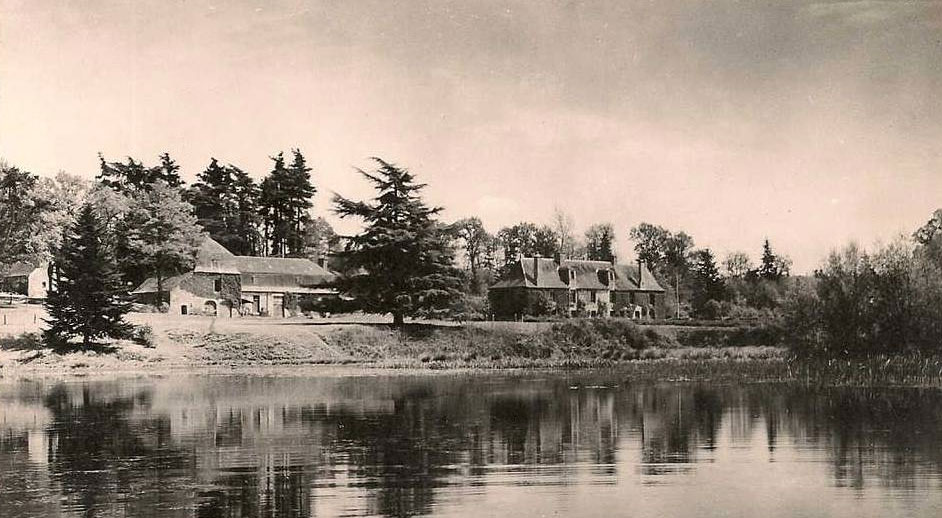
The manor of Kercado (Carcado) at Saint-Gonnery near Pontivy (56) around 1850
The first castle with tower and drawbridge was burned during the League in 1597
the second was sold nationally in 1794 and razed in the mid nineteenth century by Madame de la Pervenchères, last heir of the Kercado-Molac
the actual building has two sundials
The first castle with tower and drawbridge was burned during the League in 1597
the second was sold nationally in 1794 and razed in the mid nineteenth century by Madame de la Pervenchères, last heir of the Kercado-Molac
the actual building has two sundials
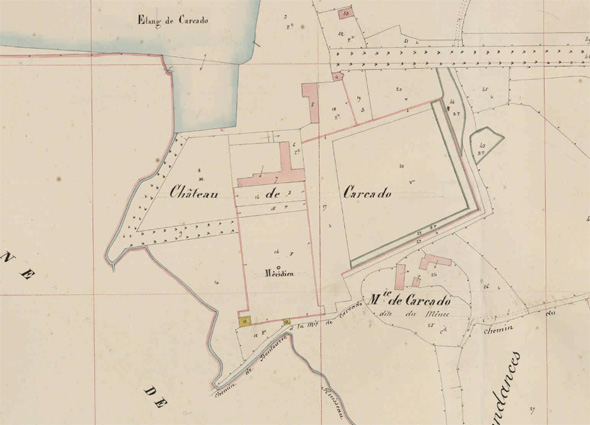
Napoleonic cadastre (see complete section)



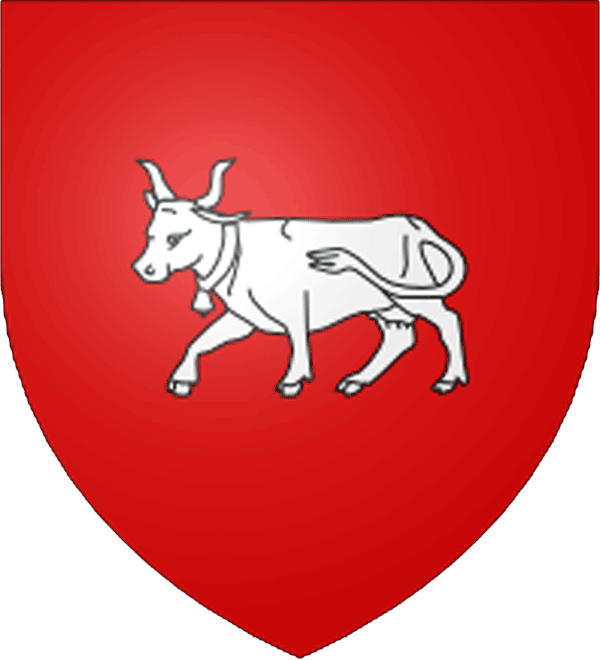



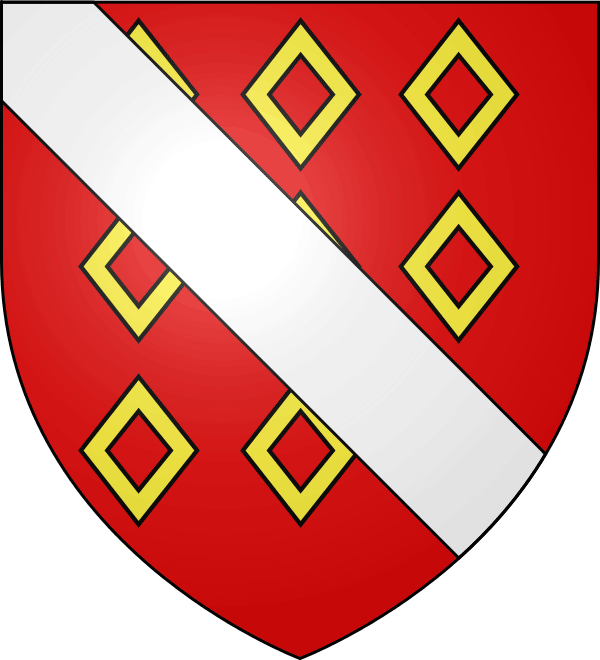

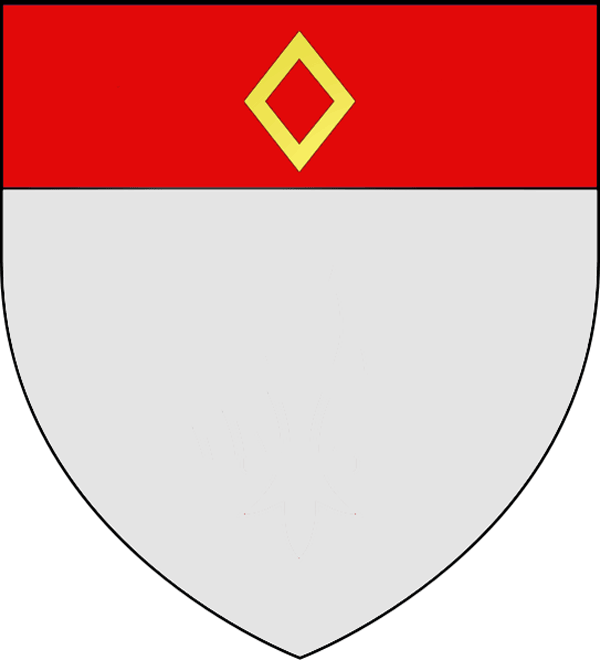
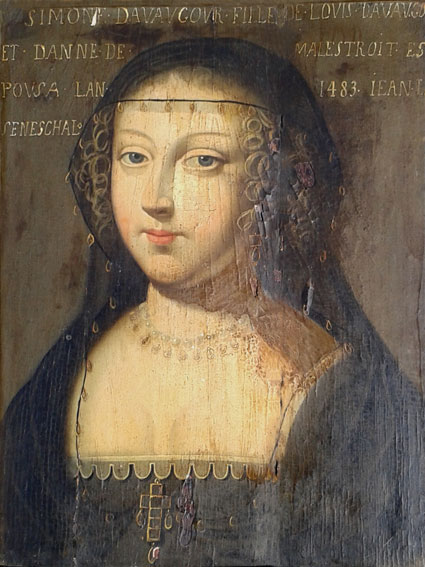
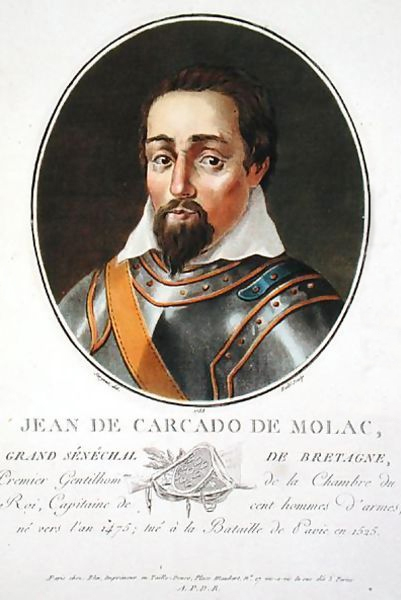
Simone d'Avaugour and her son Jean Le Sénéchal who made the sacrifice of his life to save the King François the 1st.

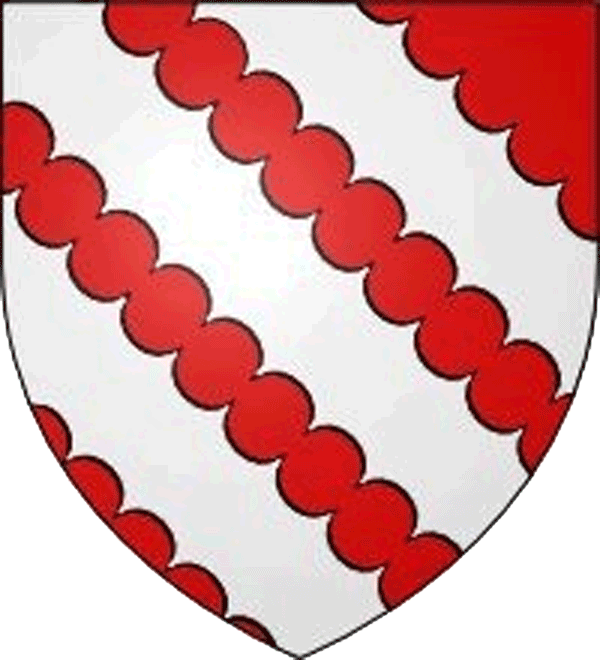


branch Le Sénéchal de Kercado-Kerguisec

The manor Saint-André in Tredudais was the residence of Britanny general treasurer Hervé Maydo in 1447 (google street-view)
Only the dependances remains and were transformed during the XVIIth century.
The Le Senechal coat of arms is still visible on the entrance gate
Only the dependances remains and were transformed during the XVIIth century.
The Le Senechal coat of arms is still visible on the entrance gate

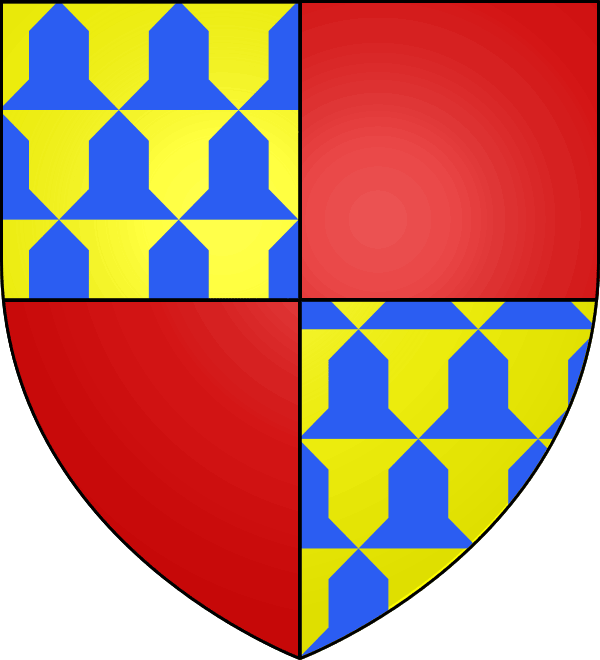
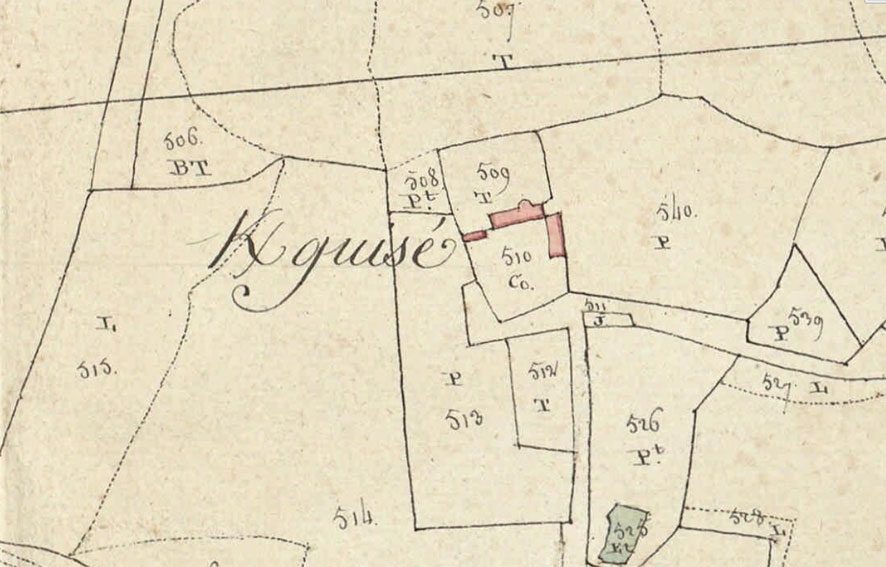
Napoleonic cadastre (see complete section)
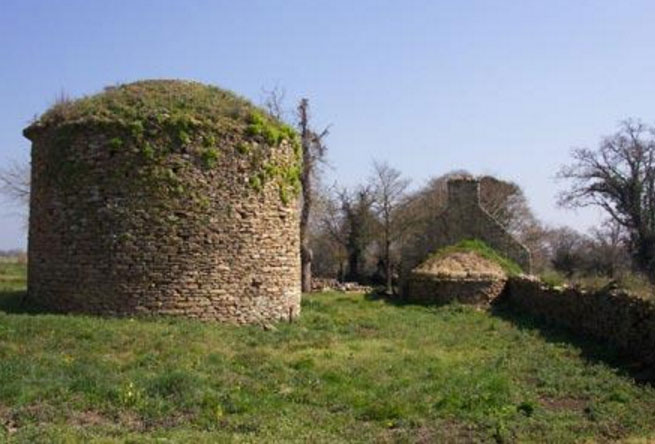
The dovecote of Kerguizec (or Kerguisé)
It is one of the few remains of the manor, together with an oven and the ruins of the chapel
Kerguisec has been the residence of these Le Senechal until it burned in 1673.
It is one of the few remains of the manor, together with an oven and the ruins of the chapel
Kerguisec has been the residence of these Le Senechal until it burned in 1673.

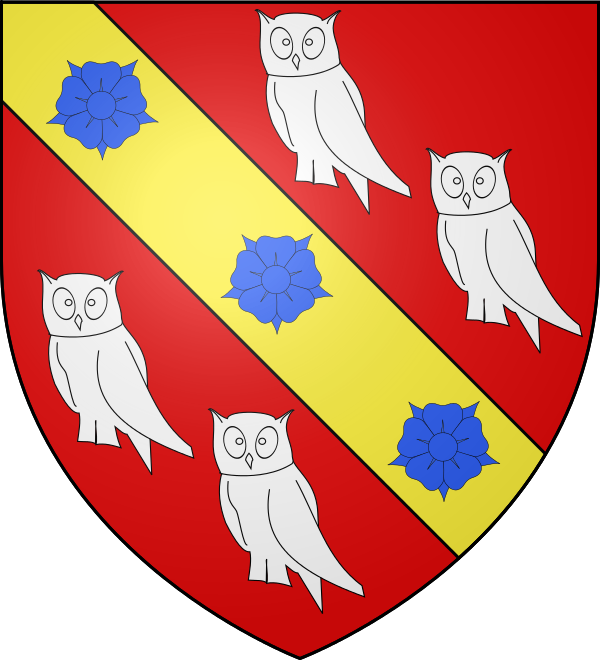
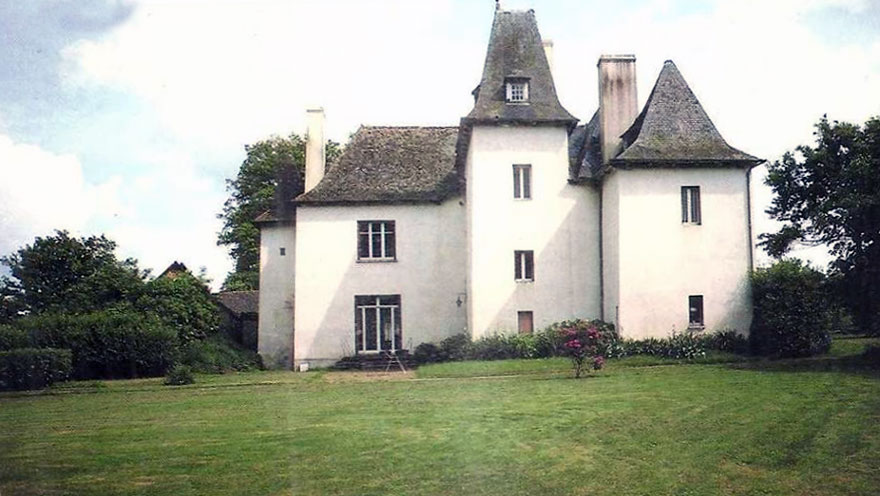
The castle ("Vieux-Logis") of the viscounty of Pacé was in the family in 1658.
It became the property of the seminar of Rennes in 1688
It became the property of the seminar of Rennes in 1688
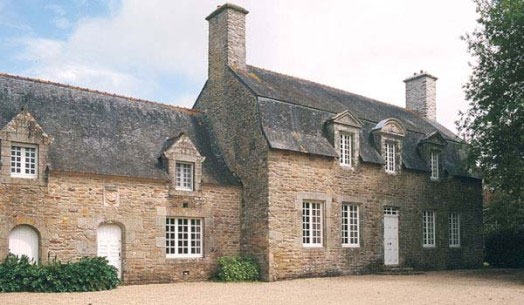
The manor of Cohanno
His castle having burned in 1673, Jean made his residence in Cohanno and restored the manor
On one skylight we can see the date 1677 and the arms of the Le Senechal
It remained in the family until 1857
His castle having burned in 1673, Jean made his residence in Cohanno and restored the manor
On one skylight we can see the date 1677 and the arms of the Le Senechal
It remained in the family until 1857

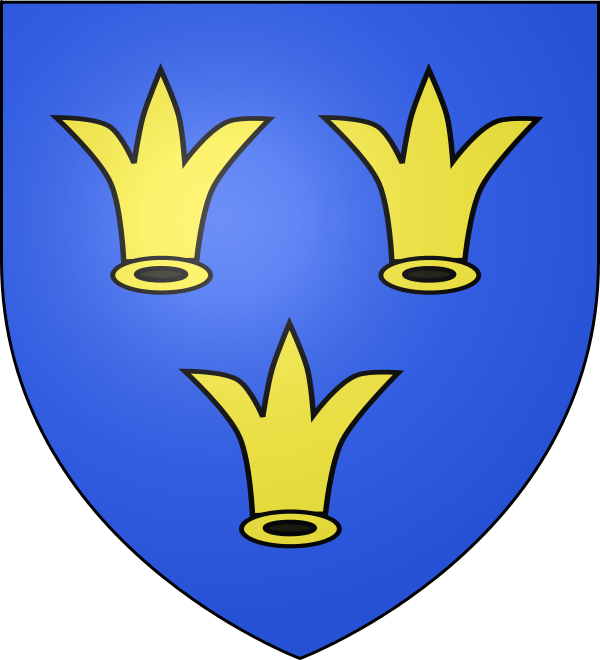
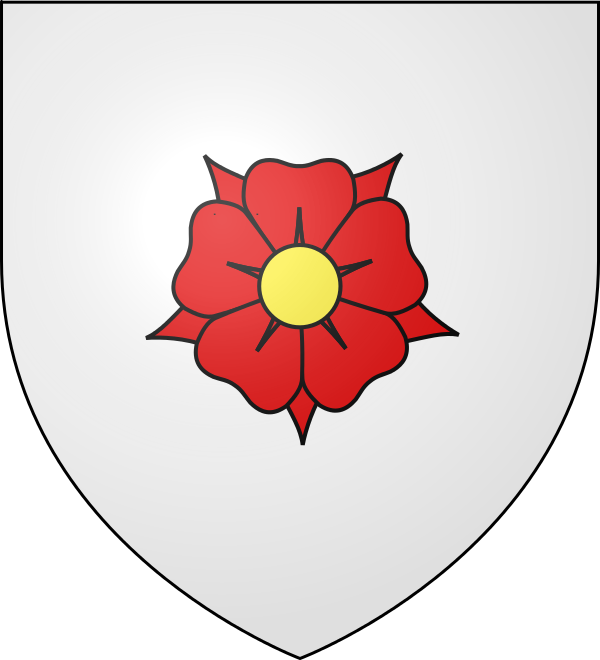

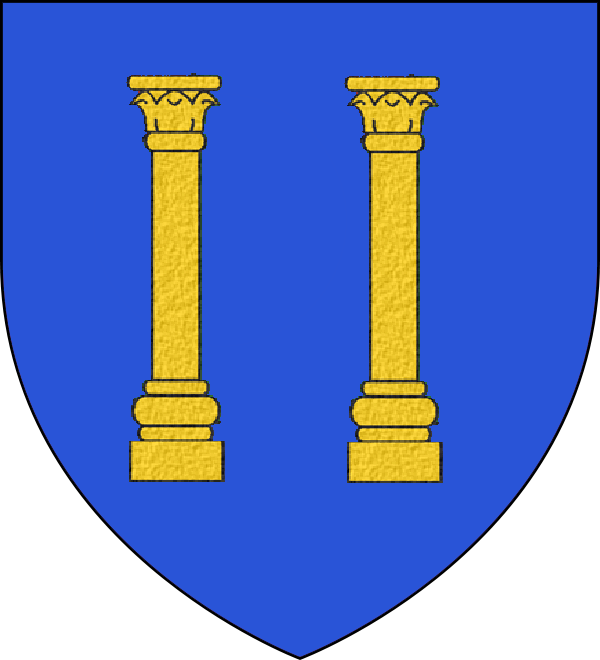

Portrait of Alfred-Boniface, earl of Kercado-Kerguisé, abt 1855
He is one of Jacques-Alexandre-Marie-Innocent's grand-son
and the last male of the Kercado-Kerguisé branch remained in France
He is one of Jacques-Alexandre-Marie-Innocent's grand-son
and the last male of the Kercado-Kerguisé branch remained in France
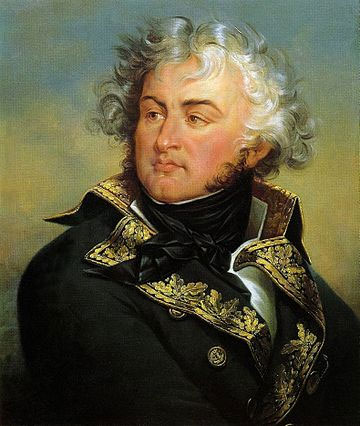
Portrait of general Kleber by Adèle de Kercado (1830)
Adèle, a famous painter, is one of the earl of Kercado-Kerguisé (Jacques-Alexandre-Marie-Innocent)'s daughter
Adèle, a famous painter, is one of the earl of Kercado-Kerguisé (Jacques-Alexandre-Marie-Innocent)'s daughter
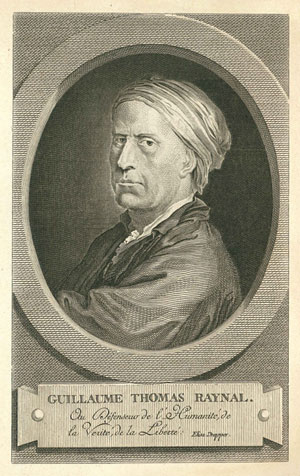
Abbé Raynal (see here)
The Kercado were close friends of him among the planters
and even parents since Marie-Jean-Prudent, one of Luc-Julien'sons, married a Raynal.
The Kercado were close friends of him among the planters
and even parents since Marie-Jean-Prudent, one of Luc-Julien'sons, married a Raynal.
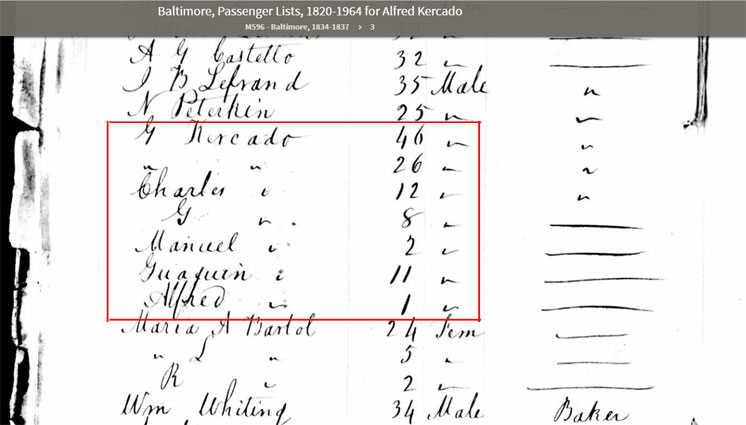
Extract of the passengers list landing to Baltimore 2 apr 1839
The second name corresponds to Mercedes Solis who was 20 years younger than her husband
Charles could be the eldest son but he is not found elsewhere
The second name corresponds to Mercedes Solis who was 20 years younger than her husband
Charles could be the eldest son but he is not found elsewhere

1850 Federal Census Pennsylvannia-Bucks-Falls
Should we trust these data, Joaquim was born 1828, Rachel 1831, Gustavus 1836, Francis 1838, Emmanuel 1841, Alfred 1843 and Lawrence 1848
Should we trust these data, Joaquim was born 1828, Rachel 1831, Gustavus 1836, Francis 1838, Emmanuel 1841, Alfred 1843 and Lawrence 1848
